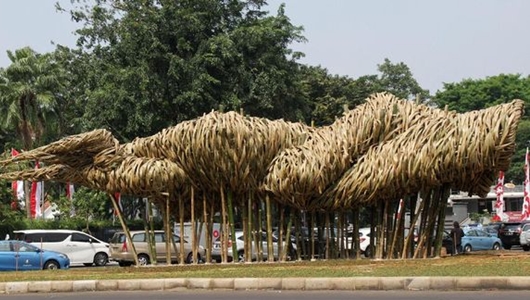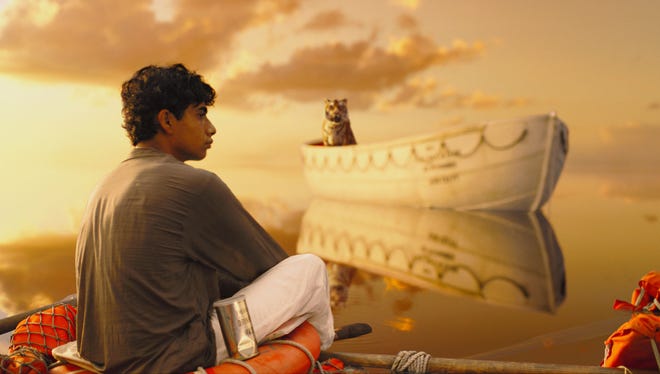I am talking about the opening ceremonies of multi-sports events. Considering I am too lazy to do some research, I will make my own obviously-invalid conjecture about how they came into being.
It seems the elaborateness started on the 1980 Summer Olympics held in Moscow. I assume the USSR tried to compensate for its human rights violations and impoverished populace by bringing out the ‘positivity’ that was the opening ceremony.
I have that assumption because it is no secret countries all over the world, even ones more well-off than the USSR, actively bearing deceptively friendly and warm facades on the international stage. No matter how free and peaceful their countries are, they all need propaganda… and opening ceremonies of multi-sports events make a really good one.
They are the only propaganda I willingly fall for. They are the only reason why I care for some sporting events and they also successfully instil suspension of disbelief into my mind; every time I watch the ceremonies, I am willing to pretend that the host countries are all-perfect, albeit temporarily.
I have made reviews for the opening ceremonies of Asian Games and Para Games 2018 (simply because I am an Indonesian, obviously). Don’t know why it took me a long to review the summer olympics ones.
I will focus on the ones held in Sydney, Athens, Beijing, London and Rio de Janeiro, in that order. They are the summer olympics openings I have watched in their entirety.
I know I could have waited for the Tokyo one. But, I want to write this down now.
2000 Sydney
There are three things that I love about this edition: Deep Sea Dreaming segment, Nature segment and James Morrison’s Jazzy fanfare.
I love the two segments because the combination of playful and colourful visuals with soothing orchestral soundtracks result in an ethereal spectatorship. I love the fanfare because of how its energetic sounds compliment the atmosphere of a sporting event.
But, the rest of the ceremony is tacky and problematic.
In contrast to those two specific segments, the others seem to be designed solely to hype up the audience. The segment titled Arrivals even goes so far to exhibit extremely sparse visual and prefers to give spotlight to the kitsch upbeat techno music!
One of my media studies lecturers also pointed out the whitewashing in the Tin Symphony segment. Instead of showcasing the hardship of the British convicts sent to Australia, it only depicts happy early European settlers.
I also pointed to her that throughout the ceremony, one can see the Aboriginal performers observing the performances from afar. It can be interpreted either as a commentary of how Australian Aboriginals are excluded from their country’s festivities OR as a subtle middle finger to them.
It might not be ill-intentioned. But, combined with the historical whitewashing, it can send a wrong message.
2004 Athens
The conclusion unfortunately feels cold and I think the use of trance music during the parade of nations emits an off-putting vibe of self-indulgence. But, at the same time, it is the most artistic and thought-provoking opening ceremony ever… and I said that without any sense of exaggeration.
The Allegory segment really does live up to its name. It is a dream sequence (and I am a sucker for dream-like atmospheres) which features a giant, floating Cycladic head sculpture breathtakingly arising from the body of water with geometric imagery projected onto it. Then, the sculpture breaks into pieces, revealing a more sophisticated sculpture of a human torso inside… which breaks again, revealing another human torso sculpture. A white cube also arises from the water with a man tries to balance himself on it, all while images of human beings and humanity’s achievements projected onto the sculpture’s broken pieces. The segment ends with the pieces land on the water, representing the Greek islands.
Basically, it is an allegory about the evolution of human civilisations and present-day Greece is one of the starting points. I adore this segment for its skilful storytelling with no expositions needed. Anyone with basic knowledge in history will easily get it.
The Clepsydra segment is also a unique segment. It depicts Greek history and mythology. But, how they are depicted struck me. It took me some time to realise the moving things on those carts were not animatronics, they were actual people with painted bodies who deliberately moved like animated sculptures!
It is refreshing from the usual routine of performers wandering all over the venue. It feels less like watching an entertainment show and more like visiting a museum; for someone who loves visiting museums, it is certainly a strength.
I always wonder about the performers: were they dancers, actors or models? I thought about those three professions because they clearly require mastery of our body languages.
The presence of Björk, a musician known for her intense musical exploration, surely bolsters the event’s overall artistry as well.
2008 Beijing
I know people will rip me for this (as if my essay will ever blow up): this edition is too overrated.
The more mature I get, the more I see how tacky it is. In fact, it is as tacky as the Sydney one. No regard for aesthetic, only for the audience’s desire for eye candy.
Okay, it is a bit unfair. The Beijing edition is certainly more grandiose and therefore, requires more discipline from the performers. Disciplined enough to work as a large collective, but still manage to look like humans instead of robots.
2012 London
Aesthetic wise, I am not that impressed. Many of the choreographies (excluding the one in the 7/7 tribute) are either awkward or basic. The one in the children’s literature segment looks like it was created by an amateur.
The event is also another pander express. It chooses to showcase the United Kingdom’s most famous aspect of life: pop culture. Of course, I do understand why the focus is not on British heritage or history; the former may be boring to non-Brits and the latter is associated with colonialism and must be executed with great tact. Pop culture is a safe choice. But, it makes the entire ceremony feels like a commercially-produced British TV show.
Strangely, I also think it has emotional profundity lacking in the other editions. The joy, the grief, the sense of wonder, they don’t feel artificial. They feel sincere.
I wonder if it has something to do with the nature of British entertainment.
From what I observe, American and Indonesian ones (especially when one talks about ‘reality’ TV shows) can be forceful with the emotions; they love to dictate the audience on what to feel. British entertainment, on the other hand, prefers to let them speak for themselves and it is always transparent about their absence.
Obviously, my statement is too simplistic as exceptions does and will always exist. But, from my personal experiences, Indonesian and American entertainment constantly annoy me with their overt-sentimentality which always comes across as insincere; British one barely annoys me like that.
2016 Rio de Janeiro
I don’t know what the fuck is wrong with this edition.
It has eye-catching visuals, it has upbeat music… and yet, it feels anaemic. It reminds me of a person who tries to put a lively and energetic facade when deep down, he/she in favour of calmness and quietness. I have such observation because the calmer segments work rather well.
My God, the environmentalist message. Why does it have to be so on-the-nose? When will people realise that blatant messages in the arts and entertainment are fucking off-putting? How will this make people accept that humans are a a part of nature and not above it?
The only thing I like about the ceremony is the acknowledgement of Brazil’s history of slavery. I love it because such acknowledge is refreshing to any countries… and because it is actually goddamn subtle and not dependent on any fucking bullshit expositions!
Which editions are my favourites?
The Athens and London ones, if you can’t tell.
Instead of completely pandering to the masses as the creative director of the Athens edition, Dimitris Papaioannou maintained his identity as an artist. Creators must be commended for that because, whether we want to admit it or not, the members of the audience were benefited by non-escapist and artistic presentations and having their horizon widened even further. Considering the global significance of the olympics, Papaioannou did millions of people a favour by compelling them to stay ‘switched on’, albeit only for a while.
And yes, I am making a big deal out of the London edition’s emotional sincerity. It is just that I am deeply revolted by the synthetic emotionality which many creatures prefer over the organic one; they prefer the former because they think being obvious equals being sincere. Running into the latter is such a nice, rare treat.
But, do you what is nicer? Fusing both strengths into one.
Can you imagine watching an opening ceremony that makes you think and feel? Right now, I can only yearn for such gratification.
.
.
.
.
.
Donate to this deadbeat, preachy blogger on Patreon.









